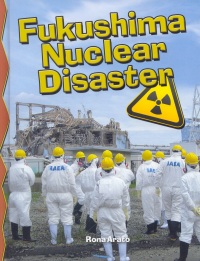| ________________
CM . . .
. Volume XX Number 32. . . .April 18, 2014
excerpt:
Fukushima Nuclear Disaster is a new book in the Crabtree “Disaster Alert!” series. The book follows a traditional organization with a table of contents at the beginning and simple glossary and an index at the end. Unlike some other books in the series, Fukushima Nuclear Disaster does not include a “Learning More” page. This is a colourful book with an attractive layout including photos, text boxes, maps and illustrations with relevant labels. Many of the photos are very dramatic moments of rescuers and victims dealing with the aftermath of the three related disasters. The book begins with an explanation of the two natural disasters that resulted in the nuclear meltdown at the Fukushima Daiichi nuclear power plant in March 2011. The strength and effect of the Tohoku Earthquake is clearly explained using text, a map, a cross-cut illustration of the earth’s crust, and a photo. The tsunami that followed is also clearly explained using similar techniques. Further chapters include “Fukushima Nuclear Plant”, which explains a boiling water nuclear reactor, and specifics about the six reactors at the Fukushima Daiichi power plant. “Nuclear Disaster”, “Nuclear Cleanup”, “Helping Survivors” and “Recovery in Japan” trace the effects of the disaster in Japan. Other chapters, “Environmental Impact”, Worldwide Effects”, “Other Nuclear Accidents”, “Be Prepared”, and “Nuclear Energy’s Fate”, look at the broader challenges of using nuclear energy as a source of power. Author Rona Arato has successfully used dramatic photos, clear illustrations, maps, and well- written text to create an engaging story of a major disaster. Whether for research or general interest, young students will find the book full of interesting information presented in a very accessible format. Highly Recommended. Suzanne Pierson is a retired teacher-librarian, currently instructing librarianship courses at Queen’s University in Kingston, ON.
To comment
on this title or this review, send mail to cm@umanitoba.ca.
Copyright © the Manitoba Library Association. Reproduction for personal
use is permitted only if this copyright notice is maintained. Any
other reproduction is prohibited without permission.
NEXT REVIEW |
TABLE OF CONTENTS FOR THIS ISSUE
- April 18, 2014.
AUTHORS |
TITLES |
MEDIA REVIEWS |
PROFILES |
BACK ISSUES |
SEARCH |
CMARCHIVE |
HOME |
